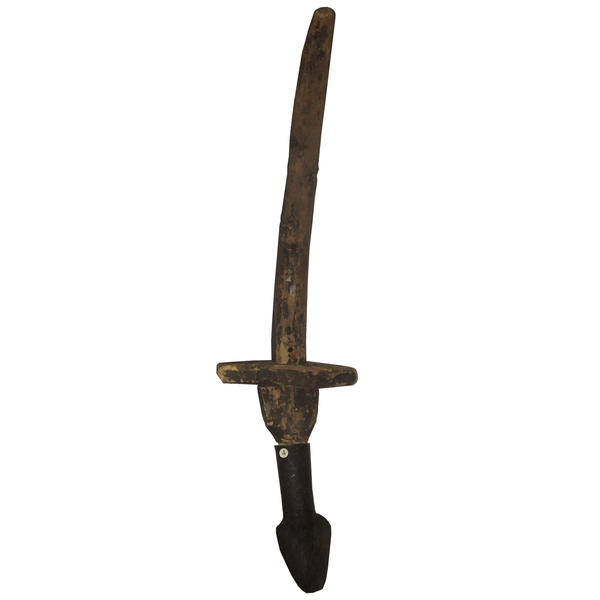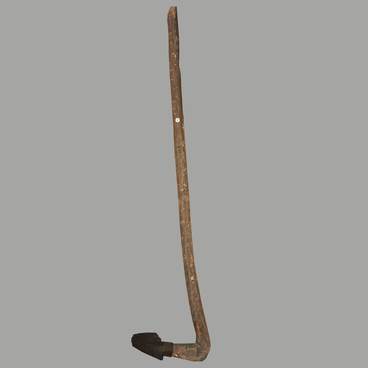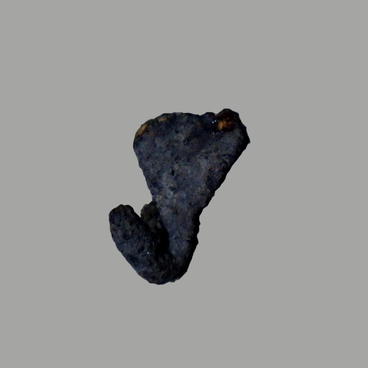An ozup is a manual soil loosening tool. It was used to dig up roots of edible plants, such as erythronium, martagon lily and many others.
Ozups traditionally consisted of a wooden handle and a metal tip. Such agricultural tools could measure about 90-95 centimeters in length.
The ozup presented in the museum’s collection was made in Mountainous Shoria, a region located in the southern part of the Kemerovo region at the junction of the Altai, Sayan and Kuznetsk Alatau mountains. The area is inhabited by Southern Shors or Kuznetsk Tatars, a small Turkic-speaking people numbering as few as 14 thousand people today.
The Shors emerged as a people in the 17th century as a result of intermixing local ket-speaking and non-indigenous Turkic-speaking tribes. Until about the early 20th century the Shors lived quite an isolated life following their ancient customs and traditions, many of which date back to the primitive era.
The Shors lived in small settlements. Their homes were built as polygonal-shaped log houses with conical roofs, half dugouts or summer huts.
Shors’ economic activities were home-based. Women were mostly involved in various handicrafts. They weaved fabrics, worked wood and leather, made household utensils out of clay. Men in Shors’ settlements were hunters and fishermen, pastoralists and farmers. Special respect among the Shors was enjoyed by blacksmiths: metal mining and processing were this people’s most important trades. But when Mountainous Shoria became part of the Russian Empire, this craft fell into decline.
The ozup presented at the exhibition was donated to the museum in the mid-1920s by Georgy Blynsky, a prominent expert in Kuznetsk local history and antiquities collector. He was born in Kuznetsk and managed the Abashevsky mine. Blynsky was a friend of another local lover of antiquity, Dmitry Yaroslavtsev. They explored the history, flora and fauna of the Kuznetsk region together, recorded their finds and observations in detail and put together a systematized collection of various artifacts.
After Yaroslavtsev’s death, Blynsky became the owner of his rich collection. In November 1927 he donated both the collection and his own house to the city, thereby starting the history of Novokuznetsk Regional Ethnography Museum.
Ozups traditionally consisted of a wooden handle and a metal tip. Such agricultural tools could measure about 90-95 centimeters in length.
The ozup presented in the museum’s collection was made in Mountainous Shoria, a region located in the southern part of the Kemerovo region at the junction of the Altai, Sayan and Kuznetsk Alatau mountains. The area is inhabited by Southern Shors or Kuznetsk Tatars, a small Turkic-speaking people numbering as few as 14 thousand people today.
The Shors emerged as a people in the 17th century as a result of intermixing local ket-speaking and non-indigenous Turkic-speaking tribes. Until about the early 20th century the Shors lived quite an isolated life following their ancient customs and traditions, many of which date back to the primitive era.
The Shors lived in small settlements. Their homes were built as polygonal-shaped log houses with conical roofs, half dugouts or summer huts.
Shors’ economic activities were home-based. Women were mostly involved in various handicrafts. They weaved fabrics, worked wood and leather, made household utensils out of clay. Men in Shors’ settlements were hunters and fishermen, pastoralists and farmers. Special respect among the Shors was enjoyed by blacksmiths: metal mining and processing were this people’s most important trades. But when Mountainous Shoria became part of the Russian Empire, this craft fell into decline.
The ozup presented at the exhibition was donated to the museum in the mid-1920s by Georgy Blynsky, a prominent expert in Kuznetsk local history and antiquities collector. He was born in Kuznetsk and managed the Abashevsky mine. Blynsky was a friend of another local lover of antiquity, Dmitry Yaroslavtsev. They explored the history, flora and fauna of the Kuznetsk region together, recorded their finds and observations in detail and put together a systematized collection of various artifacts.
After Yaroslavtsev’s death, Blynsky became the owner of his rich collection. In November 1927 he donated both the collection and his own house to the city, thereby starting the history of Novokuznetsk Regional Ethnography Museum.



